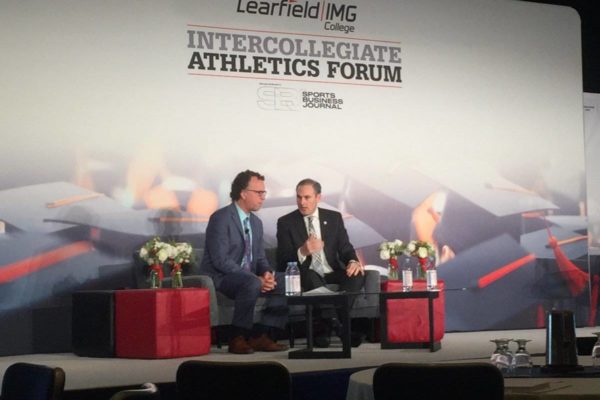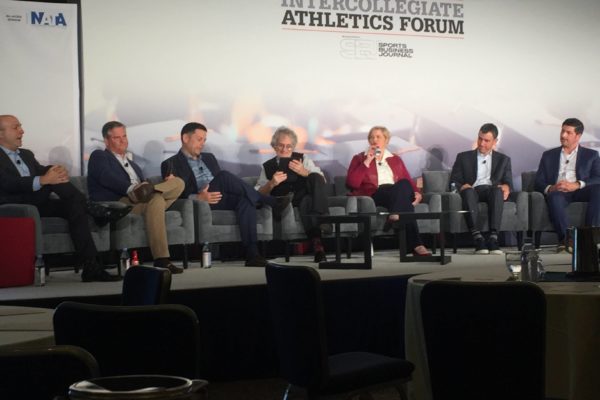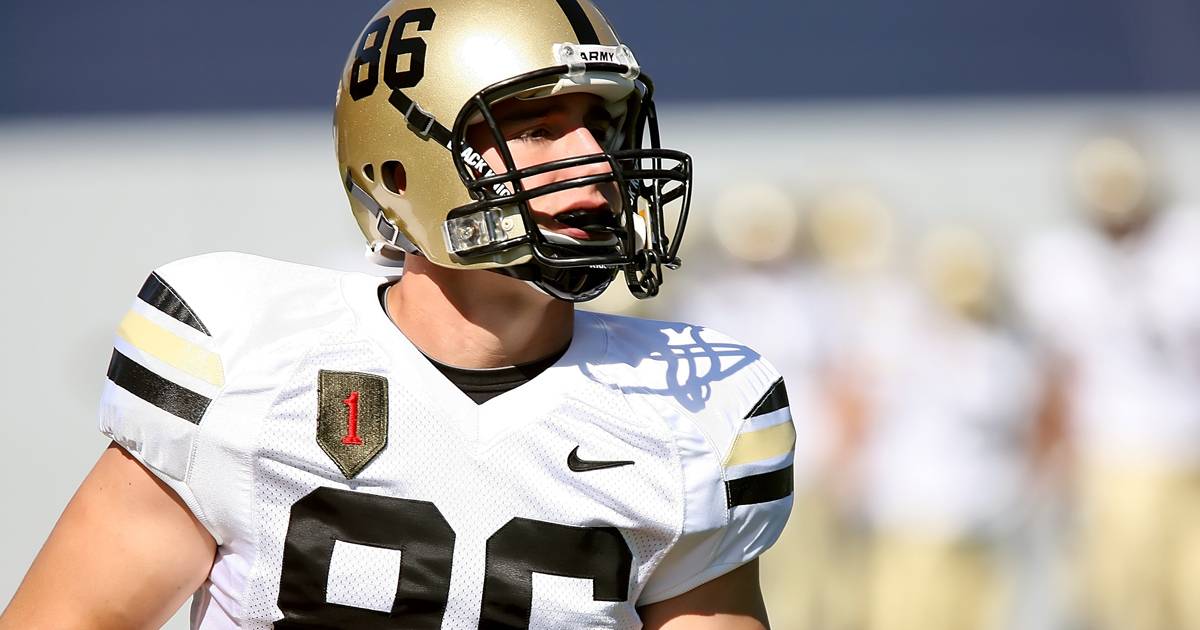Athletics is the front porch of the University.
Though it’s cliche, it’s true. But it’s missing the point — because while we marvel at the millions spent by college athletics, the objectives of the Athletics department and its programs are very similar and very much aligned with the objectives of the university.
They’re trying to attract their own ‘recruits’ – whether that’s students or student athletes, they want to keep up with their own facilities arms race, they’re chasing the same donations and government aid to fund initiatives, they’re investing in and seeking the best technology, and they’re above all looking out for the welfare, development, and health of every student on campus.
This was a key theme that emerged at the 2019 Sports Business Journal Intercollegiate Athletics Forum [SBJIAF] with college athletics leaders across panels and subject areas: the alignment of goals across Athletics and University. This includes the latent opportunity to work together to attract the best students and student athletes, and to create the best experience for them. We were lucky enough to attend the SBJIAF and took in a lot of the incredible info and insights shared from the most influential and respected leaders in college athletics speaking at the event.
We’ll focus on a few main topics and distill the primary themes, insights and takeaways from the forum, offering what those in college athletics and beyond can take away from the movers and shakers in the space.
Driving Attendance and Enhancing the Gameday Experience in College Athletics
Almost everybody is grappling with ways to drive attendance among students and overall. Sure, it’s easy to say win more games and schedule more exciting opponents, but there are so many factors that come into play and can be affected. Some of the key takeaways from the panels included:
- Temple Athletic Director Patrick Kraft discussed the community that develops among fans whose relationships exist around seeing each other at games. How can schools facilitate that culture of community, making the games feel more like a social event than watching a competition?
- Several speakers talked about the full-day experience, the experience beyond the game on the field or court. Texas Athletic Director Chris Del Conte invoked the Disney theme park outing, which is truly a full-day experience, leaving visitors exhausted but satisfied after a multi-faceted day.
- Texas Senior Executive Associate AD Drew Martin referenced the success of ‘Bevo Boulevard,’ noting that “Our fans wanted more reasons to come to the game,” and Texas wanted to give fans more reason to come and arrive early, stay late.
Likewise, Cal Athletic Director Jim Knowlton discussed the concerts that the Golden Bears have started doing before games.
- The ‘Facility of the Future’ panel talked about building fan zones, designated social spaces (including those close to the field, even with little or no sight lines), digital and experiential fan zones with interactive activations and games, and further reinforced that ‘the entire day needs to be a show.’
- Stadium shrinkage is part of the strategy, too, with SEC Commissioner Greg Sankey talking about reduced capacity but more ‘premium seating.’ Wake Forest Athletic Director John Currie made a similar point noting that “The whole stadium has to have some element of premium experience.”
- WiFi was top of mind — for the fan experience and for data collection, and noted by multiple panelists at the conference. But a less-emphasized part of WiFi is how it empowers fans to become your ambassadors by sharing their experience on social media and with their friends, inspiring the FOMO of the fun being missed out on for those not in attendance.
- When asked about increased local competition, Texas AD Chris Del Conte dropped the memorable line “I’m a big fan of R&D — rip off and duplicate.” Well-put and thought-provoking for staffs that are prone to tunnel vision.
Temple’s Kraft on driving live game attendance: Creating a community atmosphere — people come together by mutually attending games, tailgating
But student attendance is still a challenge – “We have to create a culture around it…It’s [important] revenue for us.” #SBJIAF
— Neil Horowitz (@njh287) December 11, 2019
Broadcast and OTT
Programs and conferences are producing and broadcasting more content than ever before, fueled in large part by the proliferation of over-the-top and direct-to-consumer options and capabilities. From the leaders themselves:
- Multiple AD’s talked about need to beef up in-house production capabilities on campus, resources that are useful for Athletics but also the communications and other departments across campus. Duke Athletic Director Kevin White made a salient point saying: “If you’re in a power 5 conference, you’re in the television business. And if you’re on a campus with these facilities, it (opens up) opportunity for (more storytelling).” Also mentions opportunity for students to get experience.” This isn’t just an opportunity and value for Athletics, it’s the entire University that can and should benefit and pool resources.
- American Athletic Conference Commissioner Mike Aresco was part of a chat about the AAC’s recently consummated 12-year deal with ESPN that spans ESPN’s linear and OTT properties, including ESPN+. Aresco admitted it was a change for many fans, but both he and ESPN’s VP of Acquisitions Nick Dawson made sure to note that the ‘best games’ in the conference will go on the ‘broadest reach platform’ aka the linear.
- Aresco also pointed out the increased exposure such a deal with ESPN/ESPN+ offered for all of the conference’s sports, making them as easily discoverable and consumable as the larger sports.
- Pac-12 Commissioner Larry Scott answered a lot of questions about the Pac-12 Network and the challenges vs. opportunity of going with or without a major media partner. Aresco emphasized the confidence and comfort partnering with a company like ESPN offered, with their clout for carriage, expertise, and inventory. Meanwhile, Scott’s position seemed to focus more on the flexibility and ‘optionality’ the Pac-12 Network offered, with their rights coming up in 2024.
- Another interesting note from Scott in light of the conference’s exploration of selling a minority equity piece of the conference was that it was seen as a way to get some immediate revenue to schools. They ultimately passed on offers because their initial interested investors had plans that were a little too ‘commercialized.’ He also alluded to potentially eyeing the major tech /content players as partners.

Name, Image, Likeness
Not surprisingly, NIL was a major topic of conversation. The primary concerns were around how it should be rolled out and regulated, potential issues yet to be discussed or properly dissected, and how it affects students and student athletes:
- There seemed to be unified messaging across the majority of college athletics leaders that the preferred path is with a national solution led by Congress. This was reinforced by two of the biggest players in the space, NCAA President Mark Emmert and Big Ten Commissioner Jim Delany.
- Big 12 Commissioner Bob Bowlsby noted the need for a new model, but a model that was unique to college athletics. “It’s not amateurism. It’s certainly not professionalism. It’s unique…I think the trade of an education for participation is still a pretty good deal…” He said the stark difference between the college model and the Olympic and pro models is that college athletics involves recruitment and the athlete choosing where they end up competing.
- Knight Commission Co-Chair and former US Secretary of Defense Arne Duncan was spirited on the stage, saying there should be two options on the board: Either cut loose the Power Five schools from the NCAA or create a ‘Division IV’ of sorts with their own set of unique rules.
- There was consensus, not surprisingly, that it’s imperative nothing resembling pay-for-play can prevail, as well as agreement around the idea that student athletes shouldn’t be hampered by NCAA rules when it comes to furthering their own off-field pursuits and businesses like ‘regular’ students can.
- An interesting line of discussion was offered by Texas AD Chris Del Conte about where the value comes from for athletes. Are they valuable because of their potential, he asked, or do they benefit more from the brand the school offers? And does it make sense for NIL pursuits to take place before they’ve done anything at the college level? Duncan, on the other hand, emphasized the value that high school athletes who, while few, can bring huge brands and audiences themselves to the school before they even take the field or court.
- Michigan AD Warde Manuel juxtaposed the negotiation they go through with coaches around how they can monetize their position and use things like school marks. Will there need to be a similar discussion for student athletes?
- A panel of actual student athletes talked about how important it will be for their group to be educated about NIL changes as they progress. There isn’t a lot of clarity now on where things will go, let alone the nitty gritty of how will it all look once real regulations are live.
- Finally, a less-discussed topic by mainstream media, but important and integral to any NIL movement in college athletics are Title IX concerns, with questions about equity brought up on multiple occasions at the conference by speakers discussing the future of NIL.
More on NIL from NCAA President Mark Emmert: “One of the great challenges is, How can you … create a model that provides benefits of all types above and beyond those tied to education that doesn’t immediately trigger professionalization?” #sbjiaf pic.twitter.com/IM1QMLtHyL
— Sports Business Journal (@sbjsbd) December 11, 2019
Social Media and College Athletics
Social Media is no longer an afterthought for schools and even Athletic Directors. Texas’s Drew Martin talked about how useful it for his AD Chris Del Conte, and several speakers made note of the many roles social media can play for college athletics programs, and what we should all be thinking about:
- Debbie Yow, the former Athletic Director at NC State, discussed the recent narratives around fan social media reaction affecting coach searches and hires. “I’d be surprised if (AD’s) pay attention to the groundswell on social media based off a coaching hire,” she said, also emphasizing that AD’s should know in advance what the social media reaction will be like around a hire.
- Ex-Pitt AD Steve Pederson rhetorically but poignantly asked whether a coach gets a ‘fair shake’ if there is a negative social media groundswell upon their hiring.
- Content shared on social from everyone besides the official brand/team accounts — students, fans, student athletes, coaches, alumni, ADs — is top of mind for many. programs right now. A telling stat shared (which came from Hashtag Sports) is that two-thirds of a brand’s audience in college athletics comes from non-owned accounts, so there is a lot of reach out there from social media accounts beyond the brand’s own.
- Twitter’s David Herman offered tips on driving user-generated content and sharing from students, especially those attending games, saying the key is to make sure students know that content is actually being used. Seeing a social media post or video shared on the board at the game or on the branded social accounts is tantamount to getting on the video board for the crowd cameras.
- What about student athletes and coaches? It was eye-opening for many to see student athlete social media posts either a) Asking their followers if they had any pics from their games orb) Posting watermarked photos pulled from sites like Getty. There are thousands, if not millions, of potential fans to reach by getting players content. And, helping student athletes to develop their social media brand is a hugely valuable and important part of providing the best experience for student athletes.
*Our team at Greenfly can attest to these social insights; we understand the opportunity for colleges to mobilize their ecosystem on social media from our work with universities, including success with Kansas State Athletics.
Other Topics of Discussion
Mental Health
- Mental health has come to the forefront and it is more essential than ever for schools to have mental health resources for Athletics—and for the University as a whole—to ensure a great student/student athlete experience. More schools are expanding mental health staff and Marquette Athletic Director Bill Scholl emphasized the enthusiasm he’s seen from donors wanting to help further the mental health of student athletes and beyond.
Getting bigger
- The typical talk track around conference expansion is that it’s about reaching more households, and Duke’s Kevin White noted that that did play a role for the ACC expansion in the lead-up to the ACC network. But Big Ten Commissioner Delany said it’s more than that. “It’s not only about cable homes, it’s about recruitment of students + student athletes, and federal aid dollars.”
- Another panel talked about the expansion of facilities in college athletics, but the key insight is that it’s not just Athletics trying to one-up their peers when it comes to buildings, technology, and amenities. “I don’t think Athletics is an outlier,” a speaker on the Facility of the Future panel said. “I think that’s just higher education. [All of campus is] recruiting students just like (Athletics) is recruiting students all over campus.”
Sponsorship Perspective
- ‘Instagrammable Moments’ was on the tip of everybody’s tongue at the forum.
- Adam Dettman, who is Director, Sports & Entertainment Marketing at MillerCoors, said that “Every space we look at now when we’re looking at a stadium environment…we (ask) ‘where is that spot where (a fan) will take a picture of that moment to share?’”
- College campuses are ripe for cause marketing initiatives that brands can activate around. Students are open and willing to become ambassadors for causes and in turn could transform them into brand ambassadors for the partner sponsoring the cause.
- Finally, Ellen Lucey, Director of Corporate Relations for NCAA Championships and Alliances, noted the obvious but salient fact that 50% of their events are female sports, which offers a valuable opportunity for brands looking to reach more diverse audiences.

A Summary of the Big picture for Athletics and University and How Greenfly Can Help
Revisit the opening paragraph and it’s clear the insights above support the notion that Athletics and the University have goals that are aligned, and can benefit from a solution that can help across campus.
That’s where Greenfly comes in. Our company has been helping mobilize communities across departments, customers, coaches, and more in college athletics, pro sports, entertainment and retail.
We’re the industry-leading technology in helping athletes, AD’s, and coaches get content to share; activating fans (or students or customers) to create and share content; empowering staff (or faculty or alumni) to create and share content; enabling social media takeovers across campus (or stores or teams), and much more.
Discover more about Greenfly’s powerful solution for sports or feel free to Contact Us.



